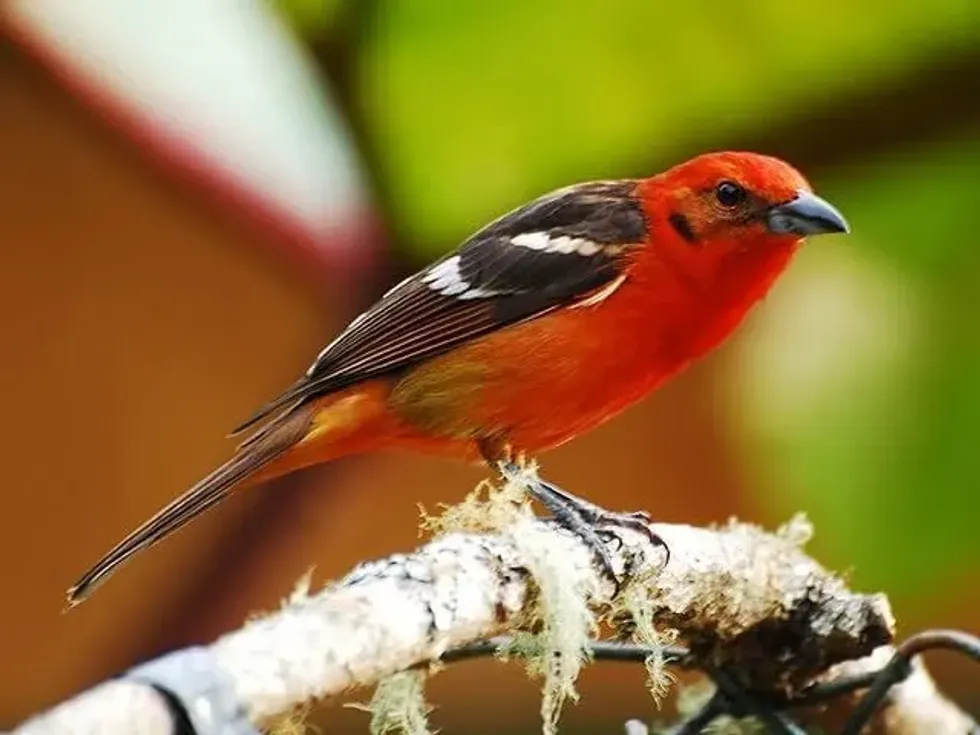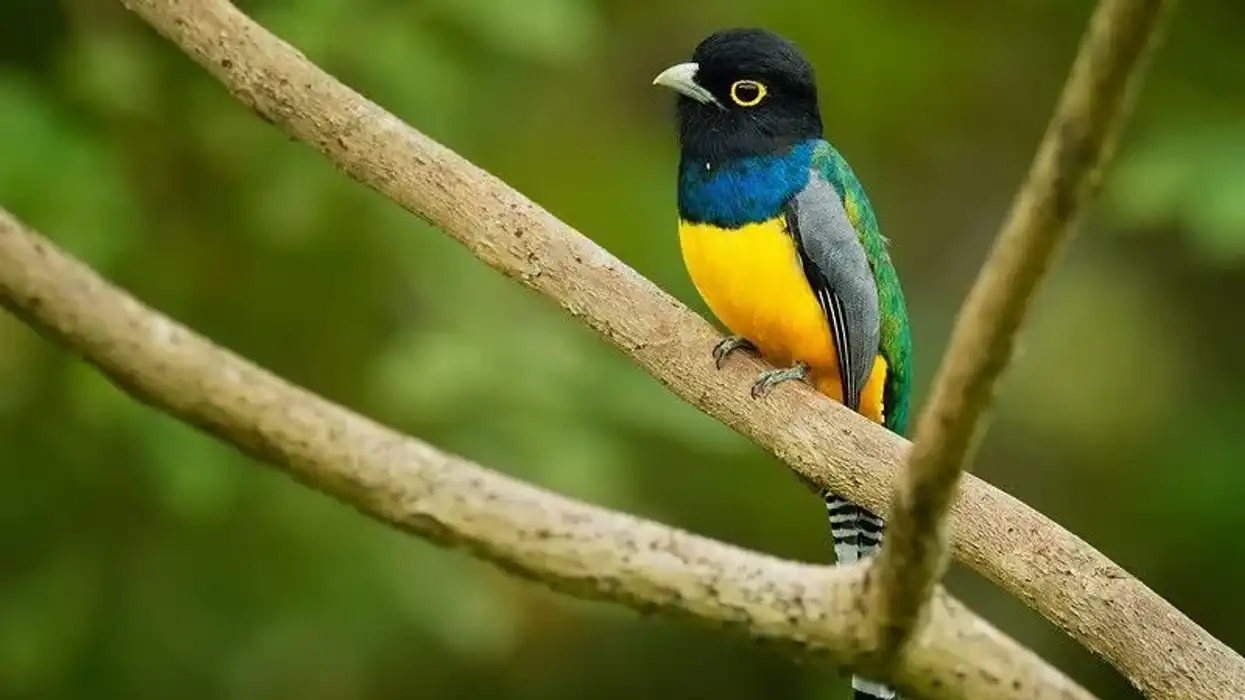These medium-sized birds, belonging to the Cardinalidae family, are native residents of North America. Their name was changed from striped-backed tanager to flame-colored tanager after their classification in the cardinal family and also because of having the flame-like color in their plumage.
These small birds have a swift flying pattern, and because of their swift flying behavior, they can forage in orchards and glean insects directly from the foliage.
The habitat of these birds is mainly found in the oak and pine forests in foothills and mountains with humid and moist weather. These birds throughout their life migrate from Mexico to Central America to the United States to other places in North America.
It is interesting to note that flame-colored tanagers (Piranga bidentata) were traditionally placed in the Thraupidae family. At the same time, today, it is believed to be closer to the Cardinalidae family.
The main reason for flame-colored tanager reclassification as Cardinalidae is its plumage color and vocalization, similar to the birds in the cardinal family. Even though the male and female look alike, it is interesting to note that the male is more red-orangish than the female, which has more yellow, making them easier to identify.
Read on to find out more about intriguing facts about flame-colored tanagers. Moreover, do not forget to check the fun facts about blue jays and eastern kingbirds.
Flame-Colored Tanager Interesting Facts
What type of animal is a flame-colored tanager?
The flame-colored tanager (Piranga bidentata) is a type of songbird native resident to North America and is mainly found in Mexico and Central America. They have often been a major topic for discussion in Ornithology due to their plumage coloration. As a result, there are many flame-colored tanager pictures available.
What class of animal does a flame-colored tanager belong to?
This bird of North America belongs to the class of Aves and the order Passeriformes and is closely related to the western tanager. The order Passeriformes contains over 6000 species.
How many flame-colored tanagers are there in the world?
These resident birds of North America are estimated to be about 2,700,000 in number. The flame-colored tanager ranges from Arizona and Texas to Mexico and other Central American countries.
Where does a flame-colored tanager live?
Flame-colored tanagers, like western tanagers, are native resident birds of North America and iare mainly found in areas of Mexico and Central America, but occasionally have also been sighted in areas of Arizona, Texas, and even Canada.
What is a flame-colored tanager's habitat?
The habitats of these birds mainly range across the oak and pine forests in foothills and mountains. The preferred habitat of this tanager bird is coniferous, pine-oak, and oak forests. The treetop canopies of the humid and moist forests in the mountains are one of the locations of their favorite habitat.
Who do flame-colored tanagers live with?
The flame-colored tanager generally lives alone. However, during migration, it travels in pairs or groups of up to 30.
How long does a flame-colored tanager live?
These bird species of North America have an average lifespan of two to three years, which is similar to the lifespan of sparrows.
How do they reproduce?
This bird is monogamous with seasonal breeding. April and May are generally the breeding months for these birds.
They prefer to build their nest on oak and pine-oak trees. The female flame-colored tanager builds its nest for laying eggs, while the males protect their territory. The flame-colored tanager female is fed and protected by the males during the nest building and egg-laying process.
The females lay about two to five blue-green eggs in their nest that is incubated for approximately 13 days. The young birds are fledged within 15 days and become independent after two weeks of fledging and fly away to build their own nest.
What is their conservation status?
The IUCN Red List of Threatened Species has listed the conservation status of this bird species as Least Concern which means that the number of these birds in their natural habitat is sufficient and is not at the brink of extinction.
Flame-Colored Tanager Fun Facts
What do flame-colored tanagers look like?

As the name suggests, these tanager birds have flame-colored bodies. These birds have a range of colors on them, but the primary visible color is the orange-red color.
Both the males and female tanager birds have red-orange plumage and brown cheeks, and dark bills. Their bill is two-colored.
The upper bill is black, while the lower one is gray. Their back is olive-green which is streaked black and has dark gray-brown wings with white wing bars. This dark-gray brown wing color is extended to the tails of these tanagers.
The male tanagers are more red-orange than the female tanagers who have a more yellow color. These tanagers are extremely mesmerizing to watch and easy to sight and identify for photos.
How cute are they?
Flame-colored tanagers are extremely cute. Their flame-colored body with an olive-green back, which is streaked with black, and dark gray wings with white wing bars, makes them pleasing to the eye and easy to identify.
How do they communicate?
These birds communicate through song, which is hoarse and high perch. The flame-colored tanager song is just like the one sung by the western tanager, but it is more hesitant. However, their call is a low 'prrrlek' similar to the western tanager.
How big is a flame-colored tanager?
The average length of this species of birds is 7-7.5 in (18-19 cm), which is slightly bigger when compared to the size of the red finch and the tree swallow.
How fast can a flame-colored tanager fly?
The actual speed of this species is not known, but it is a known fact that they are one of the few bird species that can fly backward. They have swift flying patterns, which helps them to traverse the foliage for gleaning insects. However, they are not as fast as the swift.
How much does a flame-colored tanager weigh?
The average weight of these birds is 0.07-0.8 lb (33-39 g).
What are the male and female names of the species?
The flame-colored tanager male and female birds are called cock and hen, respectively.
What would you call a baby flame-colored tanager?
The baby bird is known as a chick.
What do they eat?
The diet of this bird ranges from different types of berries, arthropods, and insects. Fruit indeed is one of their favorite foods, although they also consume insects for nutrition. These are both popular during the summer months, a season when they are plentiful.
These birds traverse through the foliage to glean insects. When other birds intrude on their food source, the bird gets irritated. As a result, this bird can demonstrate a little violent behavior while trying to fend off other birds.
Are they poisonous?
These cute-looking birds are not at all poisonous. They look extremely cute with a range of colors on them, such as orange-yellow body and olive-green back, which is streaked black, dark gray, and black wings with white wing bars.
Would they make a good pet?
This bird, which is a resident of Mexico and America, is not suitable to be kept as a pet. The bird is extremely gorgeous, but it does not adapt well to living in a house or a closed environment. Besides, it is unlawful to keep this bird as a pet in many countries.
Did you know...
This bird can hibernate for months.
It is the only bird that can fly backward.
A 'season' of tanagers is a group of tanagers that live together.
Summer tanagers are medium-sized red or red, yellow, and olive green colored birds with a pale yellow blunt-tipped bill.
The western tanagers are migratory birds that fly to Mexico and Central America in winter. The main reason for the migration of these birds is to escape deforestation and climate change.
There are no known predators as such who feed on this bird in Costa Rica.
How did the flame-colored tanager get its name?
The brilliant reddish-orange plumage of the flame-colored tanager gives it its name. Mexico and Central America are home to this tropical tanager. Its northern range goes near to the Mexican border states in the United States.
Do flame-colored tanagers migrate?
Flame-colored tanagers, sometimes known as stripe-backed tanagers, are tropics-dwelling American songbirds. These birds have a distribution range from Mexico to northern Panama. The range of this bird can go as north as Canada in North America in a similar habitat. This bird can occasionally be seen in the mountains of the United States, as well.
They migrate at night. The main reason for this migration is to escape deforestation and search for food. Even though they migrate, they are considered residents throughout their migration range.
Here at Kidadl, we have carefully created lots of interesting family-friendly animal facts for everyone to discover! Learn more about some other birds from our red-backed shrike facts and summer tanager facts pages.
You can even occupy yourself at home by coloring in one of our free printable bird coloring pages.
Main image Jerry Oldenettel.
Second image Jerry Oldenettel.










